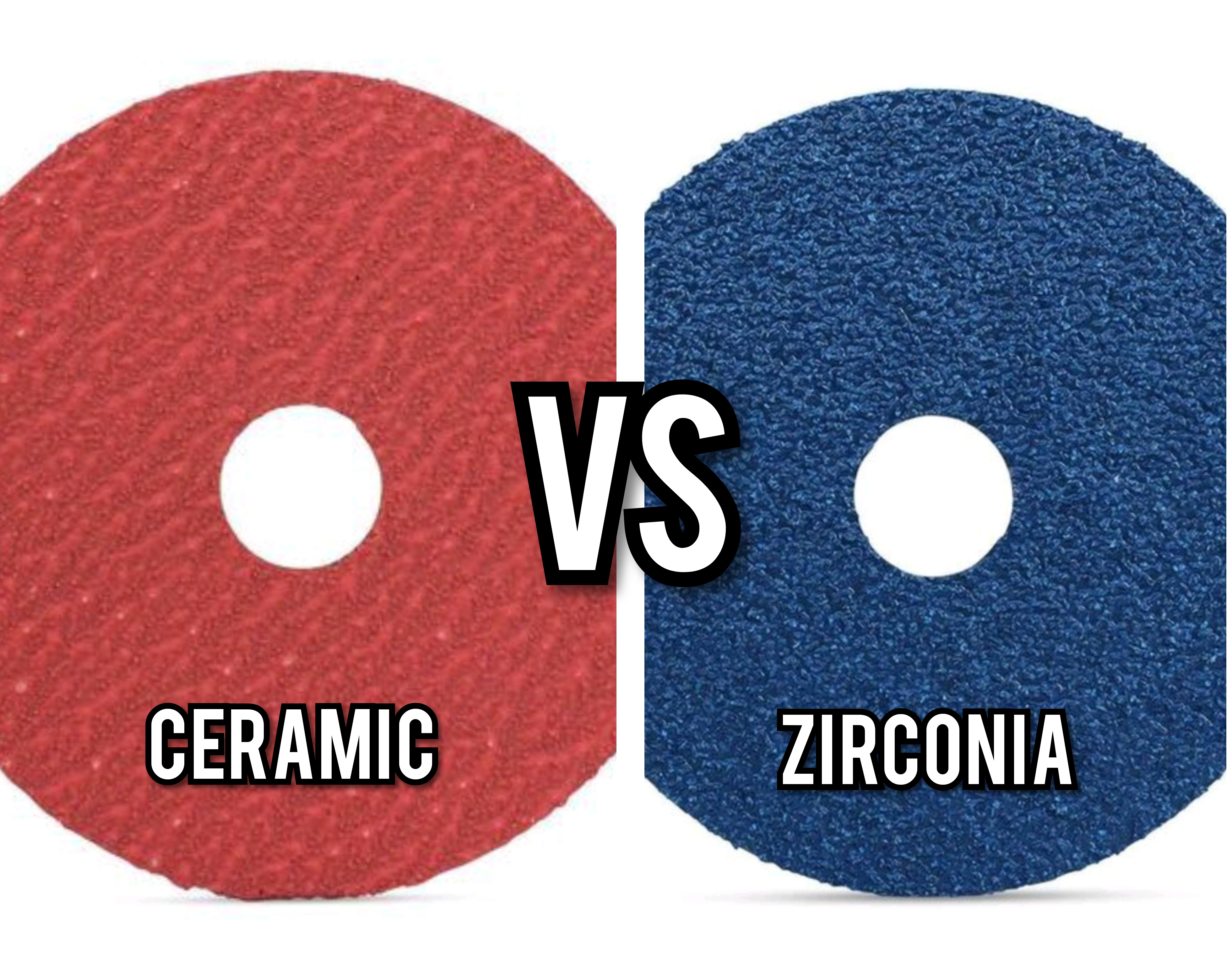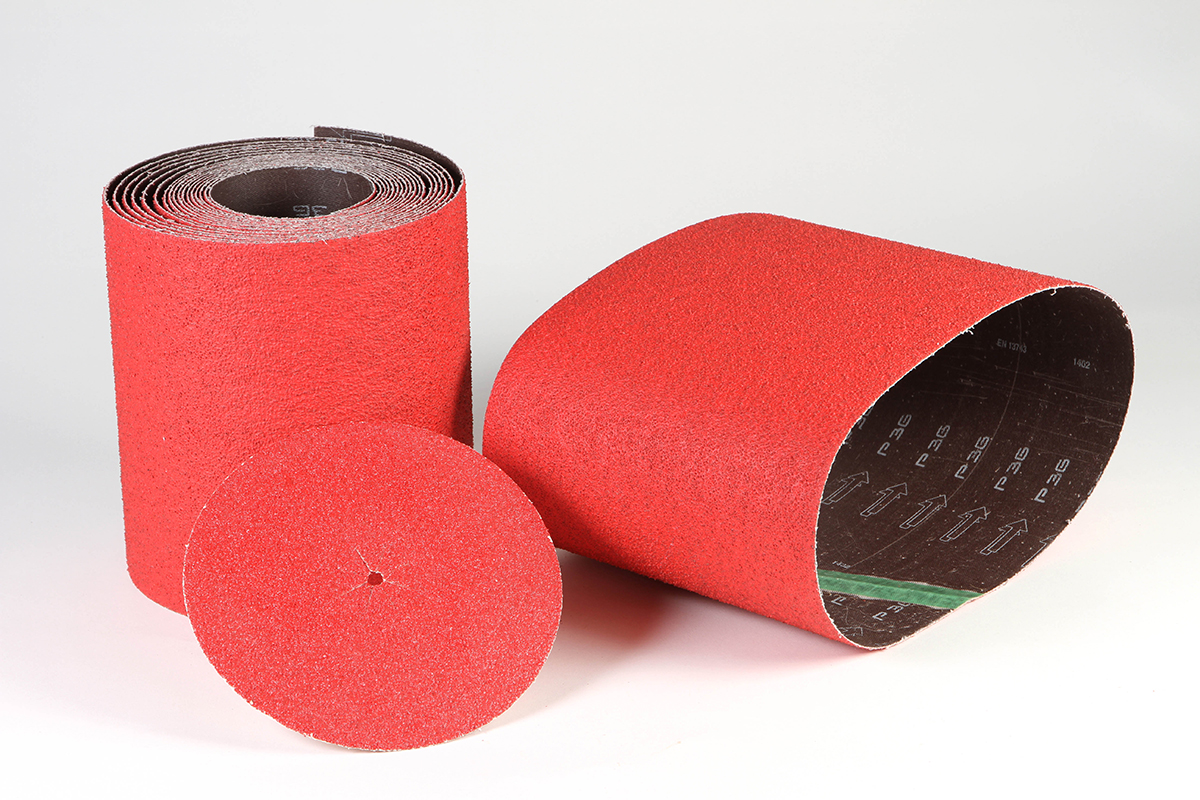
When you are working on a project you want to make sure it is completed to the best of your ability and look like it too. One of the important factors for that is choosing the best tools for your workpiece. A common question we have at Empire Abrasives is, “ What is the difference between Zirconia and Ceramic?”
Understanding the differences between these two types of abrasives will allow you to make the most informed decision regarding your purchases, tools, and materials you are using. You can find a variety of sanding belts, discs, and more in both zirconia and ceramic. While both are great for aggressive work and excel at a 24-120 grit, their differences become more apparent in their longevity, structure, and abilities.
Zirconia vs. Ceramic: Overview
As mentioned before, an abrasive material’s ability becomes more apparent in use. Almost everyone is familiar with aluminum oxide as an abrasive and is a great measuring baseline for understanding other abrasive materials. Aluminum oxide was developed to be the replacement for garnet and other brittle grains and it does fantastic on both soft and hard wood. It is also good for some grades of steel and non-ferrous metals.
However, you will eventually come across a project or source material that needs a more aggressive abrasive that lasts both longer and is better for grinding metal and that is when you will need ceramic or zirconia. Both ceramic and zirconia are high-performance abrasive grains that last much longer than the aforementioned aluminum oxide due to their strength and ability to self-sharpen with every use unlike aluminum oxide. This allows zirconia and ceramic to continuously renew themselves for maximum cutting performance until the grain is fully worn.
While both types are great for aggressive work and excel at 24-120 grit, they differ in their longevity, structure, and applications.
Zirconia Abrasives
Zirconium is made by die-casting and is generally available in the coarser grits up to 120. It is a coarse grain that has a high heat resistance and is substantially stronger than aluminum oxide.
You will commonly find Zirconia abrasives in a range of colors from light blues to vibrant greens. Zirconia is a great choice for high-pressured grinding and machining applications. It does require more pressure to sand. The belts and sanding discs will perform better for jobs on harder surfaces and are not an ideal for polishing.
Zirconia is most commonly used in steel fabrication shops. But, you will also find zirconia to be a favored choice in stainless steel cutting, grinding, and other abrasive applications.
It is great for removing burrs from very hard metals such as carbon steel, steel-iron-nickel alloy, stainless steel, tungsten, tungsten carbide, and titanium just to name a few. Zirconia is generally available on heavy cloth backings. Our closed coated zirconia belts offer more abrasive material as it is fully coated and if you need a durable abrasive for heavy sanding of rust or metal, zirconia is a solid choice. Zirconia will have a much longer life than aluminum oxide, be more friable, and provide a cooler sanding / grinding experience. Zirconia sanding discs and zirconia sanding belts are the most popular types of abrasives found in the marketplace.
Note: Although zirconia is stronger than aluminum oxide, it may struggle with grinding mill scale.
Use Zirconia on:
- Stainless Steel
- Tool Steel
- Nickel alloy
- Aluminum
- Titanium
- Cast iron
- Carbon Steel
- Blades
- Rotors
- Welds
Ceramic Abrasives

Ceramic abrasives have a unique micro-grain construction, featuring a micro-crystalline structure that allows them to break down in a controlled manner. This feature extends their range of application and their ability to work on harder metals. Compared to zirconia, the micro-grain structure of ceramic abrasives results in a more consistent and cooler grinding process, making it better for precision work and reducing the risk of thermal damage. Ceramic abrasives are available in coarser grits, up to 120, and are favored for their performance in aerospace applications, as well as on metals like titanium alloy. They also perform well on aluminum castings, stainless steel finishing, and mild steel mill scale.
As ceramic is adapted further into the industry, ceramic sanding belts in particular have made a powerful impact on both the efficiency and quality of metal grinding and sanding applications. Ceramic belts have become increasingly more popular within the knife industry for finishing high carbon steel. The micro-grain structure allows smaller fragments to break away during grinding or sanding, keeping more abrasive particles active and prolonging the product's life. Ceramic abrasives run cooler but are sensitive to heat and pressure, making them ideal for low-pressure grinding applications.
Use Ceramic on:
- Aluminum Castings
- Carbon Steel
- Ferrous Metals
- Inconel
- Mild Steel Scale
- Non-ferrous Metal
- Stainless Steel Finishing
- Titanium Alloy (and other aerospace metals)
- Tool Steel
About Grinding Aids
Grinding aids are additional layers or coatings applied to zirconia and ceramic abrasive belts and sanding discs to improve their performance. These aids help to reduce friction and heat buildup during the grinding process. This is especially beneficial when working with heat-sensitive materials like stainless steel, titanium, or other exotic metals. By reducing the temperature, grinding aids extend the life of the abrasive for a cooler, more efficient grinding experience. They also help maintain the integrity of the workpiece, reducing risks of discoloration, warping, or other thermal damage.
Examples of Products with Grinding Aids
- 2" x 72" Ceramic Sanding Belt: These ceramic belts feature a cool grinding active layer that serves as a grinding aid, helping to keep temperatures low and ensuring longer belt life, especially during intensive grinding sessions.
- 2" Quick Change Zirconia with Grinding Aid Disc: These zirconia discs include a grinding aid layer, making them particularly effective on heat-sensitive materials like stainless steel and other metals prone to overheating during grinding.
Application Scenarios
Scenario 1: Steel Fabrication
If you are working in a steel fabrication shop and need an abrasive for heavy grinding on stainless steel or carbon steel, zirconia is the best choice. It is durable, withstands high pressure, and has excellent heat resistance, making it suitable for prolonged, high intensity grinding tasks.
Scenario 2: Knife Making
For knife makers looking to achieve a smooth and precise finish on high-carbon steel, ceramic abrasives are the best. The self-sharpening properties at lower forces allow for precision grinding, and the cool running temperatures help avoid overheating, which can damage the blade.
Scenario 3: Aerospace Applications
If your project involves aerospace metals like titanium alloys, ceramic abrasives are preferred. They work well on exotic metals and provide a controlled grind, which is essential for delicate and precision-based aerospace components.
Scenario 4: Removing Rust from Cast Iron
When removing rust from cast iron, zirconia is a better option due to its high durability and ability to withstand heavy pressure. Zirconia discs can efficiently remove rust without the need for frequent replacement.
Is Zirconia or Ceramic Better?
Both zirconia and ceramic will last longer and remove metal faster than aluminum oxide. However, when you are deciding on what to use it is important to take into account the heat of the project and the pressure required for the project.
- Zirconia is better for high-pressure applications, making it ideal for heavy grinding and cutting tasks.
- Ceramic is more suited for low-pressure projects, providing a cooler and more controlled grinding experience, especially with exotic metals.
Although ceramic does last longer than zirconia, they are both excellent choices. Both abrasive grains are self-sharpening as they wear and both are primarily used on metal applications. In the end it is important to revert back to whether it is a high or low pressure as a great starting point in your decision making process.
Quick Decision Guide
- High-Pressure, Heavy Grinding: Choose Zirconia.
- Precision, Low-Pressure Work: Choose Ceramic.
- Heat-Sensitive Metals (e.g., Titanium, Stainless Steel): Choose Ceramic.
- Cost-Effective Option for Versatility: Choose Zirconia.
- Knife Finishing and Aerospace Applications: Choose Ceramic.
Quick Recap Reference:
Zirconia:
- Self-sharpening with use
- Last longer than aluminum oxide
- Works best under high pressure
- High heat resistance
- Does not work on mill scale
- Not ideal for polishing
- Performs best on harder surfaces
Ceramic:
- Self-sharpening with use (microfractures)
- Lasts longer than zirconia
- Works best under low to moderate pressure
- Great for knife finishing
- Great for titanium and aerospace metals
- Works best for low to moderate heat
- Works on mild mill scale
Zirconia and Ceramic are both excellent choices. Zirconia is overall a more versatile abrasive for the novice and the experienced. It is economically priced while being long lasting and is good for metals and woods. Ceramic has its place in the industry but is better for those who can ensure a low-pressure application or for those working on more exotic metals. Zirconia and Ceramic are both excellent choices. Zirconia is overall a more versatile abrasive for the novice and the experienced. It is economically priced while being long lasting and is good for metals and woods. Ceramic has its place in the industry but is better for those who can ensure a low-pressure application or for those working on more exotic metals.
Comparison Table: Zirconia vs. Ceramic Abrasives
| Property | Zirconia Abrasives | Ceramic Abrasives |
|---|---|---|
| Self-Sharpening | Yes | Yes (with microfractures) |
| Lifespan | Longer than Aluminum Oxide | Longer than Zirconia |
| Pressure Requirement | High | Low to Moderate |
| Heat Resistance | High | Low to Moderate |
| Best for Polishing | No | Yes (especially for knife finishing) |
| Performance on Hard Metals | Excellent | Excellent (especially on exotic metals) |
| Mill Scale | Struggles | Works on mild mill scale |
| Applications | Ferrous metals, heavy grinding, high-pressure work | Hard metals, precision grinding, aerospace, knife making |
| Cost | Less expensive | More expensive |
Chat With Our Team of experts
We offer a wide variety of Zirconia and Ceramic sanding belts and discs. If you’re still unsure or undecided please give us a call at 1-800-816-3824 or open that chat on the bottom right hand of your screen. We’re always happy to help.
